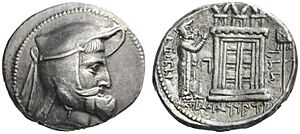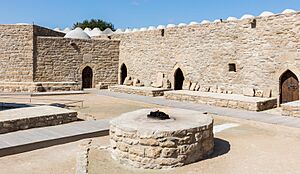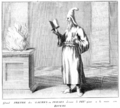Fire temple facts for kids
Quick facts for kids Fire temple |
|
|---|---|
|
آتشکده
|
|
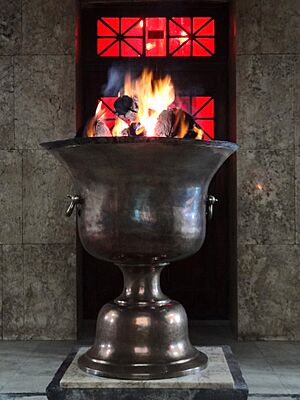
Burning fire in the Fire Temple of Yazd. Yazd, Iran.
|
|
| Religion | |
| Affiliation | Zoroastrianism |
A fire temple is a special place of worship for followers of Zoroastrianism. This is an ancient religion from Persia (modern-day Iran). In Zoroastrianism, fire (called atar) and water (called aban) are very important for religious cleansing. The ash from the sacred fire is also used in special ceremonies.
As of 2021, there were 167 fire temples around the world. Most of them are in India, with 45 in Mumbai and 105 in other parts of the country. Only 17 are in other countries. The most important temples are called Atash Behrams, and there are only nine of these. The smaller temples are known as agiaries.
Contents
History of Fire Temples
Early Ideas and Worship

The idea of using fire in Zoroastrian rituals began around the 9th century BCE. This was at the same time that fire became seen as a divine (holy) being. However, early Zoroastrians did not have special buildings for fire worship. Ancient texts do not mention fire temples.
Historians like Herodotus noted that in the 5th century BCE, Zoroastrians worshipped outdoors. They would light fires on mounds under the open sky. Temples were a much later development. Even in the Parthian Empire (250 BCE–226 CE), there were two main types of worship places. One was a sanctuary for a specific god or angel, often with a statue. The other was a "place of burning fire," which became more common as people started to dislike statues in worship.
During the Sassanid era (226–650 CE), statues in shrines were either removed or replaced with fire altars. There were mainly two types of sacred fires. The Atash-i Vahram was a continuously burning fire, meaning it never went out. The Atash-i Adaran was a smaller, local fire that was relit each year. The buildings themselves were often called simple names like "house" or "home." This showed a desire to keep the fire worship similar to the ancient tradition of the hearth fire in a family home.
The fall of the Sassanid Empire in the 7th century CE led to the destruction or conversion of some fire temples into mosques. Many Zoroastrians fled, and some legends say they carried sacred fire with them. This fire likely served as a symbol of their faith during difficult times.
Ancient Buildings and Discoveries

The oldest known remains of a fire temple are on Mount Khajeh in Sistan, Iran. These traces of foundations are thought to be from the 3rd or 4th century BCE. The temple was rebuilt and made larger during later empires.
Sassanid fire temples often had a domed room where the fire altar stood. This room was usually square with pillars supporting the dome. These ruins are often called čahār-tāq, meaning 'four arches'. Many such ruins have been found, especially in southwestern Iran. However, not all buildings thought to be fire temples actually were. Some were secular buildings or belonged to other religions.
Famous Great Fires
Zoroastrian tradition speaks of three very important "Great Fires" or "Royal Fires." These were said to have come directly from Ahura Mazda, the supreme being. They are called Adur Burzen-Mihr, Adur Farnbag, and Adur Gushnasp. Legends about these fires are very old. By the 3rd century CE, people believed miracles happened at these sites.
Ancient texts say these Great Fires existed since creation. They were believed to help spread the faith and protect humanity. These fires also became symbols of royal power. Priests at these temples would tell stories of miracles to attract visitors. Each fire was also linked to a different social group:
- The Farnbag fire was for priests.
- The Gushnasp fire was for warriors.
- The Burzen-Mihr fire was for farmers.
The Farnbag fire was considered the most sacred. It was seen as the earthly form of the "Holiest Fire" mentioned in holy texts. While today's priests see these fires as more mythological, people have tried to find their locations. The Adur Gushnasp temple is believed to be at Takht-e Soleymān in Iran. The Burzen-Mihr fire is thought to be near the village of Mihr. The Farnbag fire was moved several times, ending up in the Kavul district.
Iranshah Atash Behram

According to Parsi (Indian Zoroastrian) legend, when Zoroastrians fled to India over a thousand years ago, they brought ash from a sacred fire. This ash is said to be the base for the fire burning today at Udvada.
This fire temple did not always stay in Udvada. It was first established in Sanjan. Due to threats of war, the fire was moved several times. It stayed in the Bahrot Caves for 12 years, then in Bansdah for 14 years. After that, it moved to Navsari until the 18th century. Finally, it was moved to Udvada, where it continues to burn today.
Although many Zoroastrian fires burn continuously today, most are less than 250 years old. The special metal container used to hold the sacred fire, called an afrinagan, was not invented in India. Ancient Greek historians and Sassanid coins show similar containers were used long ago to transport fire.
Fire Temples Today
Names for Fire Temples
One common name for a Zoroastrian fire temple is dar be-mehr, which means 'Mithra's Gate' or 'Mithra's Court'. This name might come from ancient times when rituals were performed between sunrise and noon, a time protected by the god Mithra. Today, darb-e mehr usually refers to the entire sacred area.
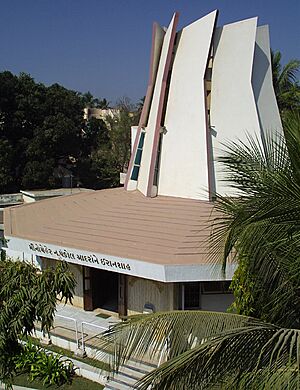
Another common term is atashkada, which means 'house of fire'. This is a more traditional Persian term. In India, the term agiary is also used, which is a Gujarati word meaning 'house of fire'. It is a direct translation of atashkada. In some places, especially overseas, dar-be mehr is used for any temple, whether the fire burns constantly or is only lit sometimes.
Types of Sacred Fires
Fire temples are named based on the type of sacred fire they hold. There are three main grades of fires: the Atash Dadgah, Atash Adaran, and Atash Behram.
Atash Dadgah
The Atash Dadgah is the lowest grade of sacred fire. It can be made holy in just a few hours by two priests. Regular people can tend this fire when no ceremonies are happening. This term can also refer to a simple hearth fire or an oil lamp in a Zoroastrian home.
Atash Adaran
The Atash Adaran is the next highest grade, meaning "Fire of fires." To make this fire holy, embers are gathered from the hearths of people from four different traditional groups: priests, soldiers/civil servants, farmers/herdsmen, and artisans/laborers. Eight priests are needed, and the process takes two to three weeks.
Atash Behram
The Atash Behram is the highest grade, meaning "Fire of victory." Creating and making this fire holy is the most complex process. It involves gathering 16 different types of fire. These can include fire from lightning, from a funeral pyre, from trades that use a furnace, and from hearths. Each of these fires goes through a purification ritual before being combined. Thirty-two priests are needed for the ceremony, which can take up to a year to finish.
Temples with an Adaran or Behram fire also have at least one Dadgah fire. The Dadgah fire is where priests perform daily rituals and where people ask for blessings. The greater fires (Adaran and Behram) are worshipped directly, with special prayers recited before them.
Here is a list of the nine Atash Behrams:
- Iranshah Atash Behram in Udvada, India. Started in 1742.
- Desai Atash Behram in Navsari, India. Started in 1765.
- Dadiseth Atash Behram in Mumbai, India. Started in 1783.
- Vakil Atash Behram in Surat, India. Started in 1823.
- Modi Atash Behram in Surat, India. Started in 1823.
- Wadia Atash Behram in Mumbai, India. Started in 1830.
- Banaji Atash Behram in Mumbai, India. Started in 1845.
- Anjuman Atash Behram in Mumbai, India. Started in 1897.
- Yezd Atash Behram in Yazd, Iran. Started in 1934.
Temple Design and Features
The outside of a Zoroastrian fire temple is usually plain and simple. This shows that the main purpose of the building is to house the sacred fire, not to be fancy.
The basic layout of fire temples today is similar. When you enter, you come into a large hall used for gatherings or ceremonies. Off to the side, there is a smaller room called an anteroom. Connected to this room, but not visible from the main hall, is the innermost holy area. This is called the atashgah, or 'place of the fire', where the fire altar stands.

A temple where important services are held will always have a source of natural water nearby, like a well or stream. This water is essential for a key part of the worship ceremony.
Only priests who work at the temple can enter the innermost holy area. This area has a double-domed roof with vents to let smoke out. The vents are offset so rain or debris cannot fall in. The walls of this inner area are often tiled or made of marble, but they are not decorated. There are no lights inside except for the fire itself. In India, temples are often designed so that direct sunlight does not enter the holy area.
A bell hangs in one corner and is rung five times a day. This marks the start of each new 'watch' or period of the day. Tools for taking care of the fire, which is always fed with wood, are hung on the wall or kept in a small room.
In India and among Indian Zoroastrians overseas, non-Zoroastrians are usually not allowed to enter any area where they can see the fire. This is a tradition, not a strict religious rule. Sometimes, entry to any part of the temple is only for Zoroastrians. Zoroastrians explain that these rules are not meant to be offensive, and similar practices exist in other religions.
How Zoroastrians Worship
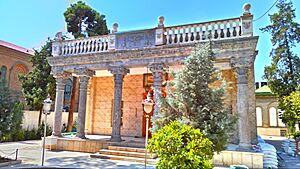
When a Zoroastrian enters the holy area, they offer dry sandalwood or other sweet-smelling wood to the fire. This offering is given to the priest. The priest wears a cloth mask over their mouth and nose to prevent their breath from polluting the holy fire. The priest then uses silver tongs to place the wood into the fire.
The priest will also offer holy ash to the worshipper using a special ladle. The worshipper can put this ash on their forehead and eyelids, and may take some home. A Zoroastrian priest does not give sermons but focuses on tending the fire. Many people visit fire temples during seasonal celebrations and especially for the New Year (Noruz).
Zoroastrian priests have different ranks. The chief priest of a temple is called a dastur. Ordinary priests are called mobads and can lead worship and ceremonies like weddings. The lowest rank is herbad, who assist in major ceremonies.
Gallery
See also
- Azargoshnasp fire temple


